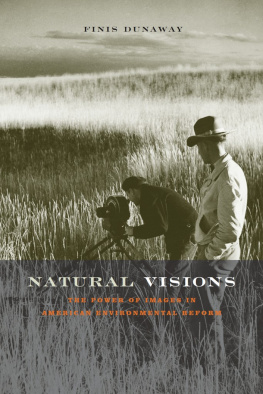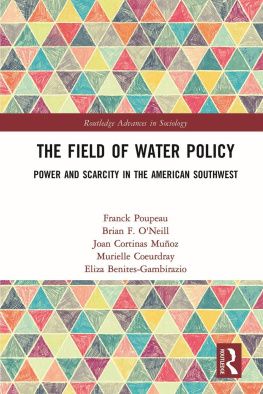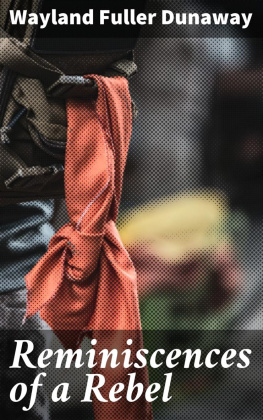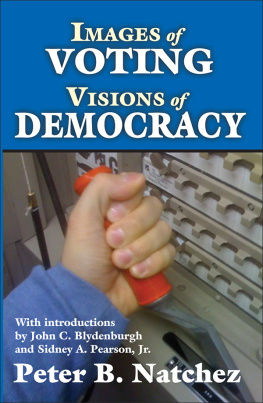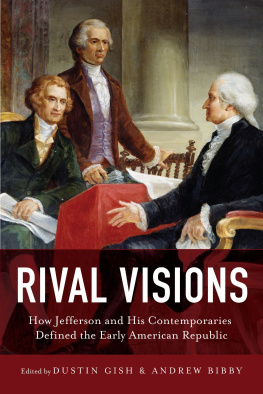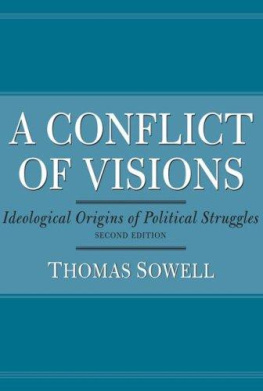The University of Chicago Press, Chicago 60637
The University of Chicago Press, Ltd., London
2005 by The University of Chicago
All rights reserved. Published 2005
Paperback edition 2008
Printed in the United States of America
18 17 16 15 14 13 12 11 10 09 2 3 4 5
ISBN-13: 978-0-226-17325-2 (cloth)
ISBN-13: 978-0-226-17326-9 (paper)
ISBN-13: 978-0-226-45424-5 (e-book)
ISBN-10: 0-226-17325-9 (cloth)
ISBN-10: 0-226-17326-7 (paper)
Library of Congress Cataloging-in-Publication Data Dunaway, Finis.
Natural visions : the power of images in American environmental reform / Finis Dunaway.
p. cm.
Includes bibliographical references and index.
ISBN 0-226-17325-9 (cloth : alk. paper)
1. EnvironmentalismUnited StatesPictorial works. 2. Nature conservationUnited StatesPictorial works. 3. Environmental protection in art. 4. Natural areasUnited StatesPictorial works. 5. Nature photographyUnited States20th century. 6. Wildlife photographersUnited States. I. Title.
GE197.D86 2005
333.720973dc22
2005008461

The paper used in this publication meets the minimum requirements of the American National Standard for Information SciencesPermanence of Paper for Printed Library Materials, ANSI Z39.48-1992.
ACKNOWLEDGMENTS
On any given day, writing a book can involve considerable pleasure and excitement, along with feelings of frustration and uncertainty. I want to thank everyone who supported me along the way and provided reassurance even when I gave them reason to doubt me. As every writer knows, it can be difficult explaining to friends and family why it takes so long to finish a project like this. So I want to begin by honoring the memory of my wifes late grandfather, Max Feldman, who provided a response that any author would dream of hearing. After listening to me describe the long process of research, writing, and revision, Max replied, Its good that it takes that long. It shows you care.
Lucky for me, I was not the only one who cared. At Rutgers University, where this book began as a dissertation, I found a wonderful group of friends and colleagues who responded to incipient ideas, suggested new directions and approaches, and inspired me by the examples of their own exciting scholarship. Although many people deserve to be mentioned, I want to thank in particular Matthew Guterl, Lucia McMahon, Peter Mickulas, Neil Brody Miller, Todd Uhlman, and Serena Zabin. Matthew Guterl deserves special thanks for reading every word of an early draft of this book, carefully scrutinizing the arguments and prose, and providing always helpful (not to mention almost instantaneous) feedback on each chapter.
I could not have asked for a better dissertation committee, composed of scholars who range widely in their approaches to studying the past. Miles Orvell, from the English and American studies departments at Temple University, was my outside reader, but you certainly would not know it from the enthusiasm, criticism, and good ideas he offered at every stage of the project. Matt Matsuda befriended me soon after I arrived at Rutgers and has consistently provided guidance on the methods of cultural history and the confusing world of academia. He knows that many of the ideas for this book were first hatched in his basement office many years ago. Susan Schrepfer helped introduce me to the exciting field of environmental history and has enlightened me on countless issues relating to the history and meanings of American conservation. James Goodman joined my committee at the perfect moment: just before I began writing. By encouraging me to tell stories, he influenced this book immeasurably. Jackson Lears, my advisor, expressed enthusiasm for this project when it was only a vague idea and continually encouraged me to embrace the interdisciplinary possibilities of the topic. Anyone familiar with his work will recognize his imprint on my thinking. I thank him not only for his careful readings of my prose but also for his friendship, sense of humor, and way of being in the world. He is a true role model.
Many other scholars offered advice and comments on portions of this work. At Rutgers, John Chambers, John Gillis, and Eviatar Zerubavel all offered constructive criticism on my early forays into New Deal film. John Rohrbach at the Amon Carter Museum carefully read the Sierra Club chapters and made many thoughtful suggestions. At Cornell, Michael Kammen read an early draft in its entirety and shared with me some of his breathtaking knowledge of American cultural history. I have never met John Meyer, a political theorist at Humboldt State University, but I want to thank him for his insightful criticism that improved the book enormously. Others who have helped me along the way include Marguerite Shaffer and Jeffrey Stine. Finally, I owe a hearty thanks to the Chapter House Beer and History Workshop in Ithaca, New York, whose members included Jeff Cowie, Joel Dinerstein, Caroline Merithew, Michael Smith, Michael Trotti, and Rob Vanderlan, for teaching me many lessons about historical scholarship, intellectual comradeship, and the venerable tradition of buying rounds.
This project was sustained by generous funding from several institutions. I wish to thank the Smithsonian Institution, the American Historical Association, the history department and the Graduate School at Rutgers University, and the Center for the Critical Analysis of Contemporary Culture for supporting my dissertation work. Since leaving graduate school, I benefited greatly from a Mellon Postdoctoral Fellowship at Cornell University. I wish to thank many people there, including Tim Borstelmann, Maria Cristina Garcia, Michael Kammen, Mary Beth Norton, and Richard Polenberg for making me feel welcome. The John W. Kluge Center at the Library of Congress provided a postdoctoral fellowship and a wonderful environment as I neared completion. Many thanks to Les Vogel and Prosser Gifford, among others, for creating a scholars paradise. An Ansel Adams Research Fellowship from the Center for Creative Photography allowed me to spend two weeks in the collections of the best modern photography archive in the United States. Finally, a publication grant from the Society for the Preservation of American Modernists provided the funding for the books color insert.
Librarians and archivists at a number of institutions provided invaluable assistance as I tracked down sources for this project. I am grateful to Leslie Perrin Wilson at the Concord Free Public Library, John Rohrbach and the staff at the Amon Carter Museum, Amy Rule, Leslie Calmes, and other staff members at the Center for Creative Photography, Bernard Crystal at Columbia Universitys Butler Library, the amazing staff at the Bancroft Library at the University of California at Berkeley, as well as countless staff members at the Franklin Delano Roosevelt Library, the Library of Congress, the National Archives, Cornell University, Harvard University, and Rutgers University.
I want to thank my new colleagues at Trent University, where I completed the book, for welcoming me to Canada, and inspiring me with their commitment to creative scholarship and innovative teaching. I particularly want to express my gratitude to the members of the history department, including the chair, Olga Andriewsky, for allowing me to defer my appointment so that I could accept a fellowship at the Library of Congress. I also wish to thank the Deans Office for the generous start-up package that helped cover the permission fees to reproduce many of the images in this book.
 The paper used in this publication meets the minimum requirements of the American National Standard for Information SciencesPermanence of Paper for Printed Library Materials, ANSI Z39.48-1992.
The paper used in this publication meets the minimum requirements of the American National Standard for Information SciencesPermanence of Paper for Printed Library Materials, ANSI Z39.48-1992.
